City of Good Fortune
As we have seen, the castle of Alamut was both the starting point and the constant power centre of the whole Ismaili movement.
In recognition of its crucial strategic importance to his cause, Hasan Sabbah renamed it “Baldat al-Iqbal” (Arabic: بلدة الاقبال ), the “City of Good Fortune”.
It was from here that messengers were sent to the outlying provinces of the disparate Ismaili state, and to which distant commanders referred for instructions and directives.
Alamut Fortress lies about two kilometres north-east of the village of Gazorkhan.
The villagers in Gazorkhan do not claim to be Ismailis but take immense pride in the fame
of Alamut.
“The pattern of their existence has remained unaltered for centuries, and they do not appear to wish for change, even though they might benefit. This is reflected in every external manifestation of their lives: their methods of farming … their local industries, such as rug-making and wool-weaving; and their dress and customs. Time seems to have passed them by. They live for the moment, and their lives are
as unchanging as the mountains around them.”, Dr. Peter Willey in the book “The Castles of the Assassins”.
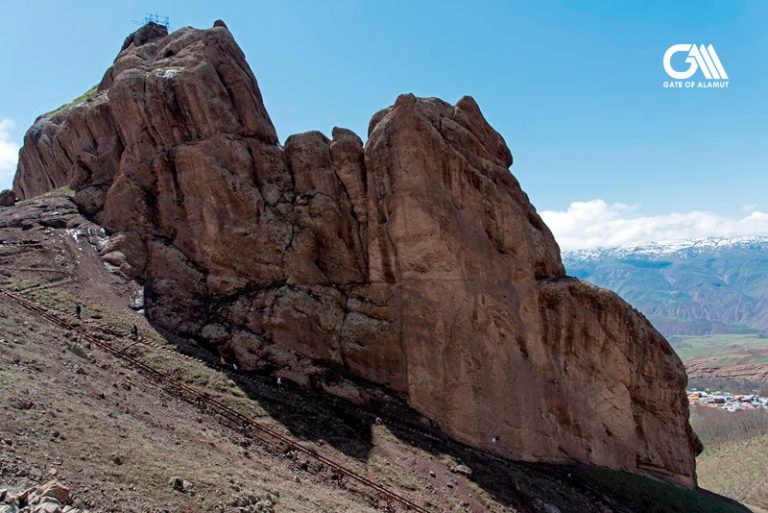
Rock of Alamut Fortress
The great rock on which Alamut castle was built is a symbol of its immense strength, rising some 185 metres above the village of Shotor Khan.
Juwayni likened its appearance to a kneeling camel with its neck stretched out, and other picturesque phrases have been used to describe it.
From a distance the rock of Alamut looks unimpressive, set against the great peaks of the Hawdeqan range, which towers behind it to a height of some 4,000 metres.
It is only when you get nearer the foot of the rock that you appreciate its immensely strong position, guarded by the other two castles of Bidelan and Maymundez.
The name Alamut, Eagle’s Nest, seems perfectly appropriate for the castle since eagles do, in fact, encircle the rock.
The colour of the rock is reddish-brown and grey, in contrast to the red sandstone of Maymundez.
It has its own haunting stark beauty when seen through the slender poplar trees that are such a feature of the valley.
The rock runs approximately north-west to south-east, consisting of the main fortifications and living quarters, about 140 metres long and varying in width from a very narrow nine to 40 metres, and a shallow southeastern protrusion consisting of a rounded bluff of sandstone rock joined to the main castle by a saddle of conglomerate rock.
The fortress was used by the Safavid dynasty in the 17th and 18th centuries as a state prison, and remains from this period still exist.
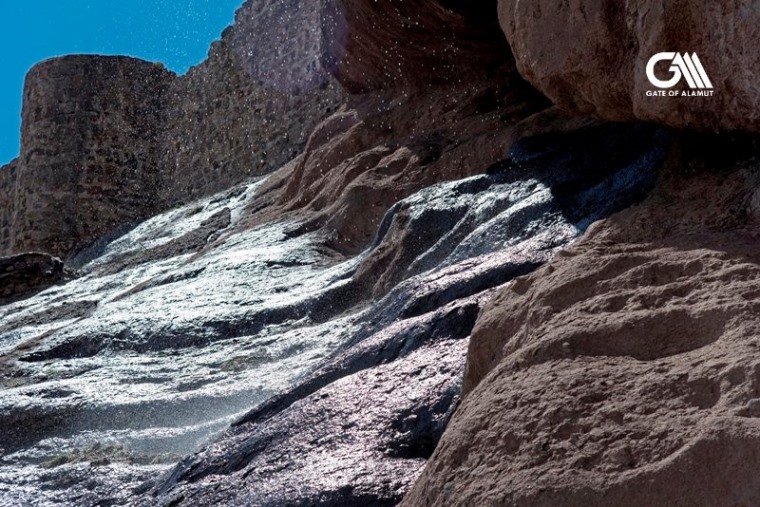
Mongolians Vs Assassins
The Mongol destruction was more vicious here than elsewhere because for these nomadic conquerors, Alamut with its library, archives
and historical associations was the very heart and symbol of Ismaili power for which they had nothing but disdain and humiliation.
The remaining different strata and artifacts at Alamut are, therefore, highly confused and, needless to say, there is little space for Hasan’s legendary garden of Paradise!
On a limited land of approx. 20,000 sqm on top of a 200-meter-high rock, it is very hard to construct a “hidden” garden. So here we can come to the conclusion that the Hidden Paradise of Hasan Sabbah was just a rumor and legend, nothing of reality.

Topography of Alamut Fortress
The topography of the area is important. Immediately to the north stands the magnificent Hawdeqan (Persian: هودکان) range, centring around the peak of Siyalan Kuh, which is 3,860 metres high. Beyond this, the Alborz mountains slope gradually away towards Ashkavar (Persian: اشکور) and the Caspian Sea. This range forms a half-circle around the Alamut rock.
Between the Hawdeqan range and the great rock is a smaller hill some 150 metres high, joined to the rock by a narrow neck. It is from this hill that the stone used for building the castle may have been quarried.
On the eastern side, there is a ravine, up which a very steep and treacherous goat track still runs, giving somewhat perilous access to the castle. The distance across the ravine is some 140 metres, after which the ground rises again.
On the southern side, the rock runs steadily down to the foot of the valley, a drop of approximately 250 metres at an angle varying between 60 and 45 degrees.
From this side, the castle offers a magnificent view over Gazorkhan and Shotorkhan to the main Alamut valley, and beyond the Taleqan range the horizon is closed by the mountains of the Chala Pass.
On the eastern side, on which it is thought that the stable and the domestic quarters of the castle were situated, the rock runs fairly steeply down to a ravine, which drops another 15 metres or so.
There is no cover from which to launch any direct assault on the castle. The impression of the strategic strength of the castle is overwhelming.
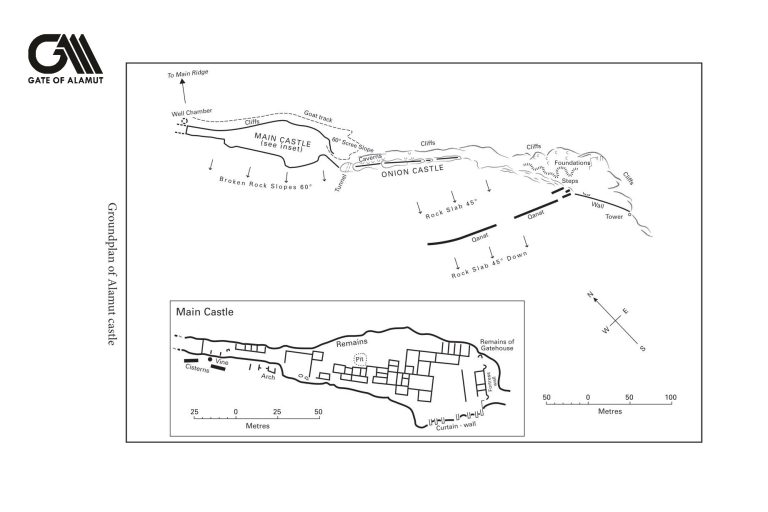
Inside Alamut Fortress
Looking across the top of Alamut castle from the north-western end, there is first of all a narrow tongue of rock which does not seem to have been used for any building or living accommodation.
There are clear remains of fortifications on each side, and on the northerly side, a lookout position is perched precariously on the rock like a swallow’s nest.
The tongue is about 45.7 metres long and 9 metres wide. Near the western end of the tongue and on the south-westerly face are two external water cisterns. They lie some 15 metres down the steep rock wall and are cut into the side of the rock.
The water level inside the cisterns remains high even during the summer, which seems to indicate that
they are fed by underground springs rather than accumulated rainwater.
The most complete part of the main castle is the big fortress wall at the eastern end, some of which still remained in 1996 (and we can still see it in 2023), though only in rubble form. Before its recent destruction, it stood about 14 metres high and was approximately 3 metres thick.
At each end were two quite well-preserved turrets faced with hard stone. Inside were the remains of staircases that wound down inside the rock, but were blocked with fallen masonry and rubble. The entrance to the fortress was through this wall and the remains of a gatehouse could still be traced. The inside of the gatehouse had been covered with white plaster.
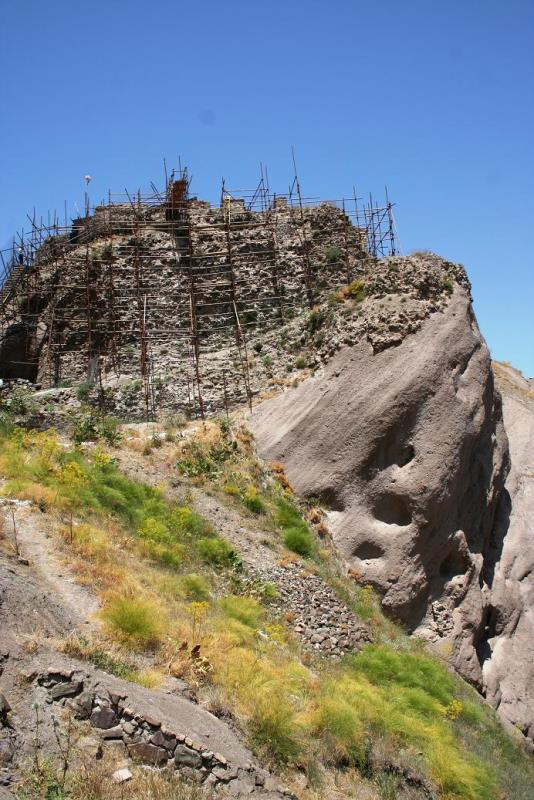
Piyaz Qal‘eh or Onion Castle
The natural extension to the main part of the rock (east side of the main gate) is sometimes called Piyaz Qal‘eh, as opposed to Pileh Qal‘eh or Great Fort, which is the name given to the western half. The picturesque name used by the villagers for the small fort is ‘Onion Castle’, because of the bulbous top that surmounts the narrow ridge. It has always been thought that Onion Castle was not fortified, but was used for stables and living quarters.
A more likely surmise is that most of the horse transport would have stayed in the villages of Shotorkhan and Gazorkhan, apart from times of direct siege. A few mules would have carried stores into the castle and perhaps been quartered there.
The main function of Onion Castle was for keeping stores of all kinds, as there was little room inside the main castle.
Near the storerooms an impressive wide, high tunnel opens out through the rock, so that it would have been possible to watch both the northern and southern approaches to the castle.
At the far end of Onion Castle are the ruins of several dwellings and a great number of shards, which suggests that this area may have housed part of the castle garrison.

A Qanat In Alamut Fortress
We also wished to examine the nature of the great horizontal crack which runs along most of the southern slope of Alamut and which shows up in every photograph taken from the valley floor.
This crack, halfway up the southern slope and actually running along its entire length turned out to be a great water channel or qanat.
The construction of the qanat is one of the most impressive features of the entire castle.
Originally there was probably a faulting in the rock, but the Ismailis succeeded in cutting out a great channel in two parallel sections some 183 metres long, with an almost constant width of 3.6 metres, and a depth that varies between 3.3 and 3.9 metres – an astonishing achievement.
In 1972 it was estimated that it was capable of holding 2,446,576 litres of water. The channel was intended both for water storage as well as a natural obstacle for any attacking forces.
Parts of the channel had been destroyed by the Mongols.
Slightly above the giant qanat are four cisterns hewn out of the rock, which were also intended for water storage.
The qanat peters out at the western end. There are no fortifications below the level of the qanat. Two flights of steps lead from the qanat to the top of the castle and are roughly hewn out of the rock.
These stairs provide rapid means of access, although it seems clear that the principal means of approach to the qanat was round the eastern side.
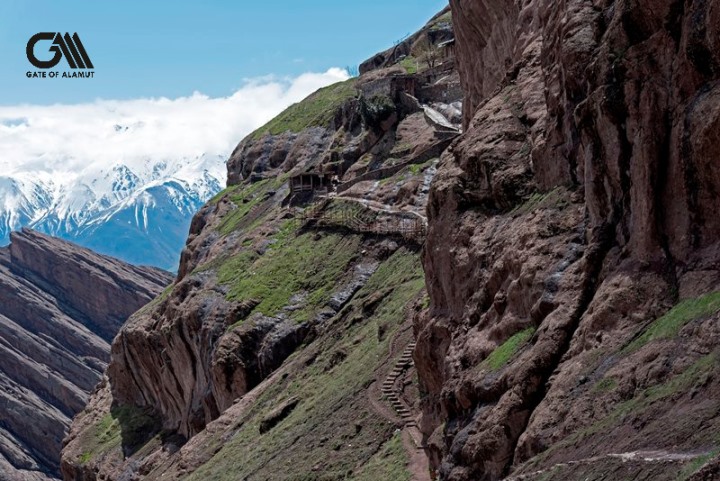
The Access Way to Alamut Castle
The only approach to the castle is by the col or depression on the north-west corner where the mule track runs.
In time of siege this would doubtless have been dug up, and in any case the besiegers would have had to pass below the garrison lining the walls on top of the castle and be met with a hail of arrows and other missiles.
There was no possibility of driving a tunnel underneath the defendants or of establishing a position above them.
Storerooms were also built into the rock.
Other fortifications were built on weak spots on the northern side overlooking the mule or goat track. These were strategically positioned to cover any dead ground or hidden places where an enemy force or
patrol could hide, and to prevent the enemy working their way up to the top of the castle along folds in the rock.

A Unique Castle Named Alamut
Considered as an example of military architecture and combined with its strategic siting, Alamut is quite outstanding.
Any European military leader of the time would have considered the extensive fortification of this precipitous rock as out of the question. It is understandable that the Mongols should have razed it almost to the ground, after burning its library and carrying off the valuable treasures it contained, lest it became the centre of future Ismaili activities.
But despite Juwayni’s boast that ‘in the breeding ground of heresy in the Rudbar of Alamut, the home of the wicked adherents of Hasan Sabbah … there remains not one stone of foundation upon another, and that the Great Khan had decided ‘that none of the people should be spared, not even the babe in its cradle’, there is considerable evidence to show that Ismailism was far from completely destroyed
after the disaster of 1256. Nor was the fortress.
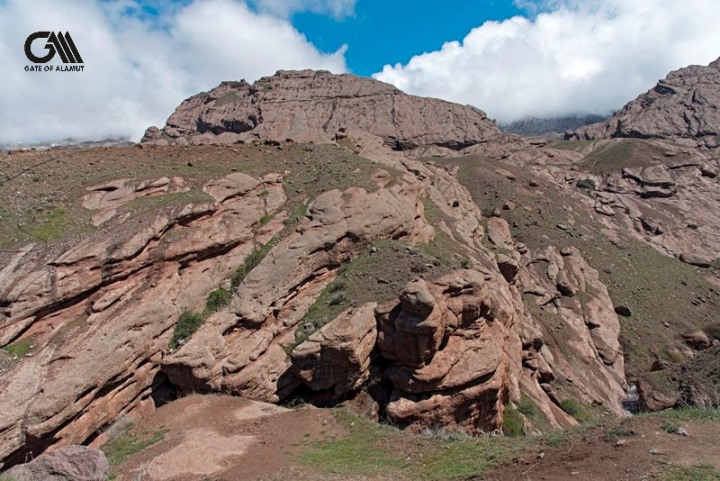
Alamut Fortress After 1256
In fact the castle was occupied again on several occasions by the Ismailis who had survived the Mongol invasions. But they did not have the strength to defend the castle and it was soon reoccupied by the Mongols.
During the Safavid period it seems that Alamut became a state prison, particularly for disgraced persons of high rank, and for this reason a part of the castle may have been rebuilt.
But from the evidence of what little remains of it today, it is highly unlikely that the great fortress was ever restored to the glory it attained under Hasan Sabbah.
The majority of the material on this post is taken from Dr. Peter Willey’s book ” The Nest of the Eagle“
Do you like to know more about the history of Alamut Castle? Then you can read my post: Alamut Castle History

Ready to book an Alamut tour with me? Then simply touch the whatsapp or email icon at the bottom of the page or go to the page Contact Us.
#alamut #alamout #alamot #ale_amut #ale_amoot #alamut_trip #alamut_tour #alamut_voyage #alamut_tours #alamut_castle #alamut_castles #alamut_history #alamut_fortress #alamut_valley #alamut_valley_tour #tour_to_alamut_valley #tour_to_alamut_castle #alamut_castle_tour #alamut_valley_guide #alamut_valley_local_guide #alamut_valley_history #assassins_history #assassins_history_iran #assassins_history_persia #castles_of_assassins #castles_of_assassins_iran #castles_of_assassins_persia #castles_of_assassins_history #history_of_assassins_iran #hashashin_persia #hashashin_order #hashashin_history #hashashin_assassins #best_alamut_guide #lambesar_castle_alamut #lamiasar_castle_alamut #lamisar_castle_alamut


Pingback: Lambsar Castle - The largest military base for the Assassins (Ismailis)
Pingback: Navizar Castle in Alamut Valley - The Unknown Castle of the Assassins
Pingback: Qazvin Caravanserai - Gate of Alamut
Pingback: Armaan in Alamut Valley - Gate of Alamut